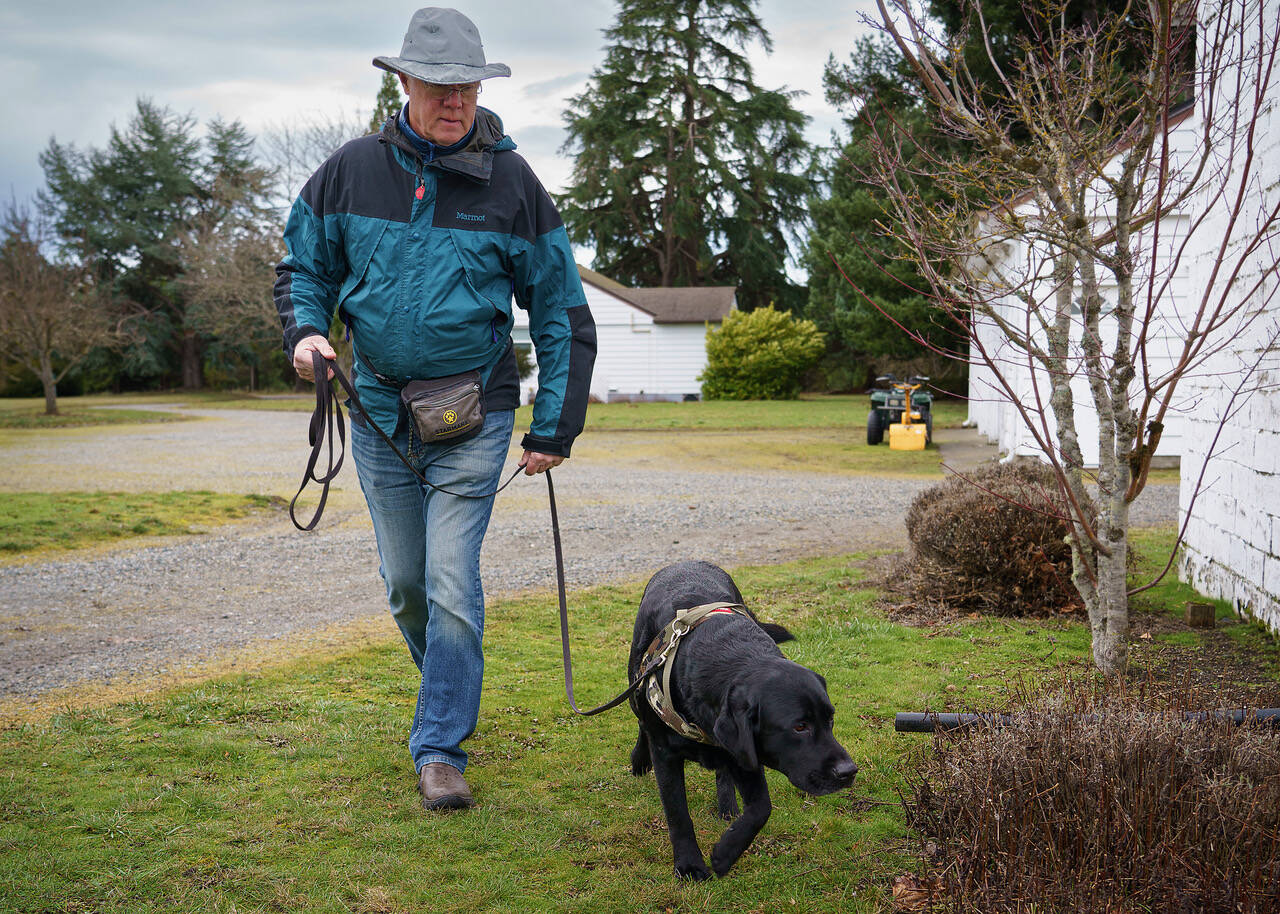By KATE POSS
Special to The Record
Nosework, also known as Scent Work, is a sport in which a dog fully relies on his own sense of smell, turning a dog’s favorite activity — using its nose — into a fun game.
In training and in competition, dogs hunt in all the venues of professional working dogs: interiors, exteriors, vehicles, containers, water and buried “hides.”
South Whidbey resident Georgia Edwards has taught nosework classes for more than a dozen years. She is a certified nosework instructor — CNWI — through the National Association of Canine Scent Work, founded in 2005. She taught popular nosework classes through South Whidbey Parks and Recreation for 13 years and is now working independently on Sundays in 2024.
“All dogs can hunt, it’s how they see the world,” Edwards said. “They rely 95% through their nose rather than their eyes. We’ve had blind dogs who do as well as sighted ones. A lot of them have a Spidey sense. They know when something’s in front of them because they can smell it.”
The American Kennel Club notes on its website that “dogs have a sense of smell that’s between 10,000 and 100,000 times more acute than ours! The sport of nosework celebrates the joy of sniffing, and asks a dog to sniff to their heart’s content.”
The hunting game helps tune canine owner/handlers into how their dogs perceives the world.
“Once you’re tuned in how they’ve indicated finding things, there is much better communication between owner and dog in all aspects of the dog’s life,” Edwards explained. “When a dog is licking a leaf, the dog is getting scent molecules from another who has urinated or defecated there. What the scent tells the dog, is what kind of animal, how old it is, how breedable, whether it’s something to fear, something to eat, something to mate with.”
Dogs have various ways of showing their owner they have located the scent. Edwards, for the classes she teaches, hides Q-Tips scented with non-toxic essential oils—typically anise, birch, clove or cypress. Upon finding the scent, dogs display a distinct and recognizable behavior – they may turn and look at their handler, sit down or even play-bow.
Edwards explained that she became interested in nosework when she was a physician-medical oncologist working in Southern California. She noticed that her dog Gandolf, a Bouvier des Flandres breed of herding dog and a hospital therapy dog, acted differently around some of her patients.
She recalled how the dog scratched at the door and leaned against a new patient who, it turned out, had advanced breast cancer.
“During her years of treatment, the dog’s behavior would change when she was in remission and when her cancer relapsed,” she said. “What he was identifying was the smell of tumor cell breakdown products in her exhaled breath.”
Subsequently, Gandolf identified metastatic breast cancer in several other patients. Edwards had other dogs who followed Gandolf who could scent patients with cancer. One of her female Bouviers successfully identified a man with prostate cancer.
After retiring from her work and moving to Whidbey Island, Edwards became interested in learning more about “doggy scent perception.” When canine nosework was introduced as a sport in 2005, she became involved with it.
“My own dog Hawkeye was the first Bouvier to have a competitive canine nosework title,” Edwards said. “He was one of the top 20 national working dogs in 2018.”
On a recent overcast Sunday, Edwards taught four 90-minute sessions with six dog-handler teams per class at the Pacific Rim Institute in Coupeville. Some dogs new to the game were given treats when they successfully located a hidden scent when paired with a treat. The more experienced dogs located the scent alone and were then rewarded by their handler with a special treat.
Shari Prior and her 7-year-old Chocolate Lab Chaya — pronounced Kie-ya — have been students of Edwards since the dog was a year old. Chaya has moved on from expecting treats each time she finds a scent box and gets pleasure from the hunt of scents alone.
When it was her turn to find the scent boxes, Chaya, thrilled for the chance to play/work, ran around the room and made huffing sounds, wagged her tail and looked at Prior when she located the scents.
“Once you start doing this, it gives the dogs great pleasure,” Edwards said. “They get excited about doing this sport.”
Prior said she finds the classes as much fun as Chaya does.
“What’s awesome about Georgia, is she’s like a preschool teacher,” Prior said. “She’s very creative when she sets up things for dogs. It’s fun for dogs and for people. An example, she always does really fun hunts for Halloween and Easter. She literally sets the room up with Easter eggs and chickens hanging from the ceiling.”
Michael and Donna Johnson have brought their dog Finn to classes for nearly a year.
“A lot of this training is for the handlers,” Michael Johnson said. “A dog knows what to do. It’s more about how to get good communication between the handler and their dog. Our dog is exhausted after this. He’ll sleep for a couple of hours. Georgia said it is because he works so hard, it’s like he has a computer in his nose.”
At an earlier class, Deborah Fisher and her dog, Kai, a spirited American Eskimo dog, noted what benefits she and her dog get from nosework.
“Nosework has been the perfect thing to help keep a high-energy American Eskimo dog like Kai busy and engaged,” Fisher said. “I love watching her solve problems and it’s fun and relaxing for both of us. The bond that develops through training also enhances the trust in our day-to-day relationship and I think contributes to Kai being a more well-rounded dog.”
To learn more about the art of nosework, visit Edwards’ webpage “Whidbey Nosework” at caninenosework.com.



